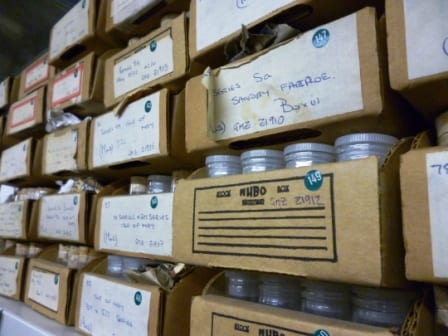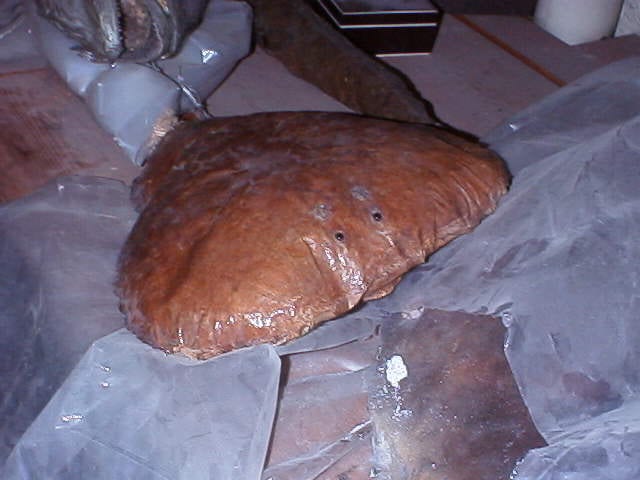It Came From The Stores: The live show
By Mark Carnall, on 26 July 2012
Last Tuesday the Grant Museum ran the event IT CAME FROM THE STORES, the live and expanded version of my occasional blog post series exploring material normally found in the Grant Museum stores. From tiny robotic fish from the future, through mysterious spheres to deliberately infected cow worms. We find that visitors to the museum are surprised to learn that only a small percentage of the collection is on display (only 5%, which is quite good going for a natural history museum) and you can see from the expressions on their faces they are picturing a storehouse a la Indiana Jones filled to the ceiling with relics and treasures of great power. My lecture sought to explain a bit about why we have stores in the first place, why some material will always be store-bound as well as to examine some of the weird and wonderful things that can be found down… down IN THE STORES DUN DUN DUN.
Natural history museums have a dual role, one is to be a (normally) public facing institution on the front line, engaging visitors with science as well as promoting the important work that museums do. The second role is also to act as scientific repository for the care of the material record of life on earth, in most instances for perpetuity. This is why there’s a lot of material in the stores of natural history museums and not on display as for any given species, ideally there would be a series of specimens for study. Studying a large sample pool of specimens results in findings that more accurately reflect general rules, patterns and trends that help scientists to model the natural world. From museums specimens we can model physiology, ontogeny, morphology, populations, environments, diet and with a time series collection the changes in these features over time. So this explains why natural history museums have so many specimens, like the small section of a 10,000 strong collection of insular mice pictured above, but also why it will never be enough.
In the lecture I recalled a discussion I had with a researcher who was studying baboon locomotion and needed to look at the skeleton of feet. Now baboons are animals that have a high chance of being in a museum. They are terrestrial, large, easy to identify, charismatic and being primates, in a group that is well known and studied. In theory there are probably tens of thousands of baboons in natural history museums. However, in order to undertake a good study the researcher was only looking at feet in adults and required specimens of disarticulated feet because they needed to be measured with a good provenance (collection locality and date). By the time you rule out all the specimens that aren’t of use for this study; wet specimens, taxidermied baboons, articulated skeletons, skeletons without feet, sub-adult or juvenile specimens etc. the sample set diminishes from a potential tens of thousands to hundreds. Throw in other logistical complications like our researcher only having funding to travel to a certain number of places as well as a number of specimens that were wrongly identified or otherwise unavailable and the sample size hovers near double figures. Research collections- many specimens of the same species, account for a lot of the material held in museum stores but there are some other object categories that account for stored material.
Specimens prepared for research often end up in stores as they aren’t really appropriate for display. This includes repeat sections, DNA samples, microscope slides, scanning electron microscope stubs and samples embedded in plastic or wax. The specimens themselves may still be useful in research or alternatively can serve as worked objects to show the changes in techniques used in zoology throughout time.
Then there are specimens that can’t be displayed because they are unsightly or otherwise just grim. Some preparation techniques haven’t stood the test of time the poor specimen pictured above may have started life as a museum object as badly taxidermied or may have gone bad over time. Fluid specimens require constant monitoring and conservation to stay topped up and putting objects on display inevitably degrades them over time. It can be difficult for museums to display this material without appearing unprofessional or that they aren’t doing their job properly but I’ve found that visitors like to see these specimens and hear about the difficulty in meeting the very ambitious goal of preserving everything for perpetuity.
Other stored material includes the weird, the wonderful, the experimental and the downright disturbing but you’ll have to stay tuned for future installments of It Came From The Stores to discover some of those stories. Alternatively, the Grant Museum currently has an small exhibition in our pigeon hole space in the entrance of the museum showing some of the material that was covered during the event so if you can’t wait until then do head down to the museum and see the undisplayable, displayed.
A UCL Events blogger came along and you can read what they took from the event on the UCL Events Blog
13 Responses to “It Came From The Stores: The live show”
- 1
-
2
UCL Museums & Collections Blog » Blog Archive » Specimen of the Week: Week Forty-Four wrote on 10 August 2012:

[…] who has seen our recent exhibition It Came from the Stores would now know that past curators have accessioned some pretty strange stuff in to a museum whose […]
-
3
Specimen of the Week: Week Ninety-One | UCL UCL Museums & Collections Blog wrote on 8 July 2013:

[…] it has been named ‘Specimen’. Oh yes. That’s almost as good as our exhibition It Came From The Stores. […]
-
4
Specimen of the Week: Week Ninety-Four | UCL UCL Museums & Collections Blog wrote on 29 July 2013:

[…] it has been named ‘Specimen’. Oh yes. That’s almost as good as our exhibition It Came From The Stores. […]
-
5
Grant Museum Objects on Tour: Lost Labels | UCL UCL Museums & Collections Blog wrote on 1 August 2013:

[…] I mentioned in a previous blog post in order for our specimens to be of the most possible use in scientific research, we want to know […]
-
6
Specimen of the Week: Week Ninety-Five | UCL UCL Museums & Collections Blog wrote on 5 August 2013:

[…] it has been named ‘Specimen’. Oh yes. That’s almost as good as our exhibition It Came From The Stores. […]
-
7
Specimen of the Week: Week Ninety-Six | UCL UCL Museums & Collections Blog wrote on 12 August 2013:

[…] it has been named ‘Specimen’. Oh yes. That’s almost as good as our exhibition It Came From The Stores. […]
-
8
Specimen of the Week: Week Ninety-Seven | UCL UCL Museums & Collections Blog wrote on 19 August 2013:

[…] it has been named ‘Specimen’. Oh yes. That’s almost as good as our exhibition It Came From The Stores. […]
-
9
Specimen of the Week: Week Ninety-Eight | UCL UCL Museums & Collections Blog wrote on 26 August 2013:

[…] it has been named ‘Specimen’. Oh yes. That’s almost as good as our exhibition It Came From The Stores. […]
-
10
Specimen of the Week: Week Ninety-Nine | UCL UCL Museums & Collections Blog wrote on 2 September 2013:

[…] it has been named ‘Specimen’. Oh yes. That’s almost as good as our exhibition It Came From The Stores. […]
-
11
Specimen of the Week: WEEK ONE HUNDRED- WOOOO | UCL UCL Museums & Collections Blog wrote on 9 September 2013:

[…] it has been named ‘Specimen’. Oh yes. That’s almost as good as our exhibition It Came From The Stores. […]
- 12
-
13
Science Research in a Science Museum? | UCL UCL Museums & Collections Blog wrote on 13 November 2014:

[…] gladius) and fortunately, one of these specimens, matched the specifications for research (in this article I wrote about how ‘usable’ specimens dwindle to tens from thousands depending on the […]
 Close
Close




At the risk of sounding stupid, is the ‘pillow fish’ in the photo real? I just Googled the name but only came up with disappointing printed fish on pillows and cushions…